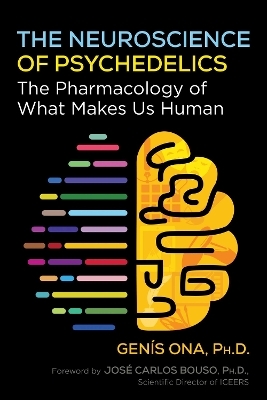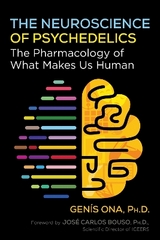The Neuroscience of Psychedelics
Inner Traditions Bear and Company (Verlag)
979-8-88850-004-0 (ISBN)
• Examines the main pharmacological properties of psychedelic substances, including LSD, DMT, psilocybin, ayahuasca, mescaline, ketamine, ibogaine, salvia, and MDMA
• Explains the physiological mechanisms behind visionary effects, including what is happening in the brain and how each psychedelic is processed by the body
• Shares safe strategies for using psychedelics, including harm-reduction techniques, and looks at where the future of psychedelic therapies is likely to go
With the widespread legalization of marijuana and the increasing use of psychoactives in controlled therapy settings, further research and understanding of psychedelics is now possible. Yet while individual accounts of their use abound, exactly what’s happening to the brain and body when using these substances is still not widely understood.
Longtime pharmacological researcher Genís Ona presents a comprehensive look at the main pharmacological properties of psychedelic substances, including LSD, DMT, psilocybin, ayahuasca, mescaline, ketamine, ibogaine, salvia, tropane alkaloids, and MDMA. Exploring how psychedelics work within the brain, Ona shares results from his extensive research to reveal the physiological mechanisms that allow these molecules to have their visionary effects, explaining what is happening at the receptor level as well as the “cascade” effects that differ from substance to substance. He examines how the body processes each substance, describing how each psychedelic is released, absorbed, distributed, metabolized, and eliminated. He also details possible dangerous interactions between these substances and other drugs as well as their potential toxicity.
Although his main focus is the biological and neurological effects of psychedelics, Ona also explores the mystical and spiritual dimension of psychedelic use, particularly as practiced in Indigenous traditions, showing how they enable access to a profound spiritual territory. He shares safe strategies for using psychedelics and looks at where the future of psychedelic therapies is likely to go, with an emphasis on ensuring that traditional knowledge is respected, honored, and protected.
Genís Ona, Ph.D., is a psychologist specializing in pharmacology research. An associate professor at the Universitat Rovira i Virgili (URV), he is a member of the Spanish Society of Psychedelic Medicine and of the working group on psychedelics at the Catalan Society of Psychiatry and Mental Health. He has published more than 50 peer-reviewed scientific articles about psychedelic drugs. Currently working as a study coordinator in the psychedelic trials taking place at Sant Joan de Déu Hospital, Barcelona, and in the Medical Anthropology Research Center at URV, he lives in a house in the middle of the wooded Catalan mountains.
Foreword by José Carlos Bouso, Ph.D.
Preface
1 Brief Introduction to Pharmacology
Etymological Origins
Main Pharmacological Concepts
Nervous System • Neurons, Synapses,
and Action Potentials • Pharmacokinetics and
Pharmacodynamics • Neurotransmitters • Receptors •
Modifying Receptor Function
Why Psychedelic Pharmacology?
Pharmacology and Complexity
References for Further Study
2 Pharmacological Classification of the Main
Psychedelic Drugs: Structures and Major Groups
Simple Tryptamines, including Psilocybin
and DMT
Ergolamines, including LSD
Phenethylamines, including Mescaline and MDMA
NMDA Receptor Antagonists, including Ketamine
New Tryptamines
Atypical Psychedelics
Tabernanthe iboga • Salvia divinorum •
Datura stramonium
References for Further Study
3 Biological Targets of Psychedelic Drugs
Simple Tryptamine Targets
Psilocybin • DMT and Ayahuasca
Ergolamine Targets
LSD • LSA
Phenethylamine Targets
Mescaline • MDMA
Targets of NMDA Receptor Antagonists,
including Ketamine
Targets of New Tryptamines
Targets of Atypical Psychedelics
Ibogaine/Noribogaine • Salvinorin-A •
Datura stramonium
References for Further Study
4 Characteristic Aspects of Psychedelic Pharmacology
PHARMACOKINETICS
Initial Phases of the Processing of Psychedelics
Release • Absorption • Distribution
Metabolism
Metabolism and Aging •
Main Centers and Enzymes Responsible for Metabolism
Relevant Aspects in the Metabolism
of Psychedelic Drugs
Psilocybin • DMT/Ayahuasca • LSD • MDMA • Mescaline •
Ketamine • Ibogaine/Noribogaine • Salvinorin-A •
Tropane Alkaloids
Elimination
PHARMACODYNAMICS
Therapeutic Effects of Psychedelics
Antidepressant, Anti-inflammatory, and Neuroprotective
Effects • Therapeutic Effects of Atypical Psychedelics •
Increased Neuroplasticity • Neurological Evidence of
Psychedelics’ Therapeutic Effects • Hormonal Effects •
Psychological Effects
Microdosing Psychedelics as an Emerging Trend
Adverse Effects in the Therapeutic Use of Psychedelics
Toxicity • Studying the Safety of Psychedelics • Health Risks
When Using Psychedelic Drugs Therapeutically
Psychoactive Effects of Psychedelics
Data on Psychedelics' Psychoactive Effects
Tolerance
References for Further Study
5 Harm Reduction in Your Use of Psychedelic Drugs
Take Care of Yourself • Check What You Bought •
Don’t Get Creative with Routes of Administration •
Keep Hydrated • Don’t Mix • Be Patient
6 A Look into the Future: Promises and Challenges
Marketing of Psychedelic Therapies
The Role of Traditional Knowledge
To Trip or Not to Trip
Appendix I: The Legal Status of Psychedelic Drugs
around the World
Appendix II: Glossary
Index
| Erscheinungsdatum | 30.09.2024 |
|---|---|
| Vorwort | José Carlos Bouso |
| Zusatzinfo | Includes 8-page color insert and 45 b&w illustrations |
| Verlagsort | Rochester |
| Sprache | englisch |
| Maße | 152 x 229 mm |
| Gewicht | 429 g |
| Themenwelt | Sachbuch/Ratgeber ► Gesundheit / Leben / Psychologie ► Esoterik / Spiritualität |
| Medizin / Pharmazie ► Medizinische Fachgebiete ► Neurologie | |
| Naturwissenschaften ► Biologie ► Humanbiologie | |
| Naturwissenschaften ► Biologie ► Zoologie | |
| ISBN-13 | 979-8-88850-004-0 / 9798888500040 |
| Zustand | Neuware |
| Informationen gemäß Produktsicherheitsverordnung (GPSR) | |
| Haben Sie eine Frage zum Produkt? |
aus dem Bereich




